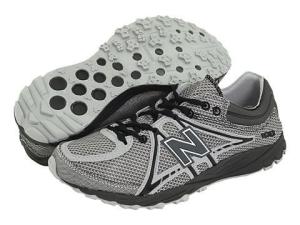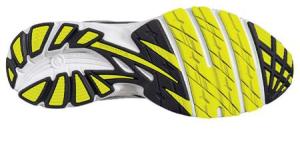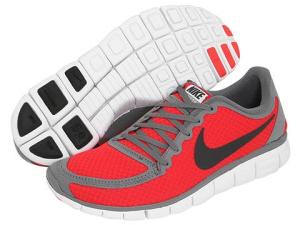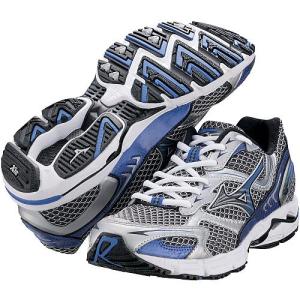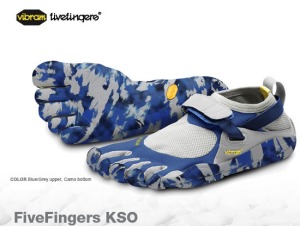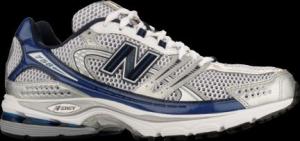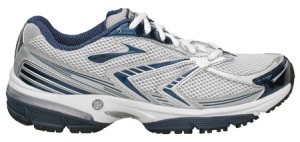MT100
New Balance
Neutral
Impression
The MT100 performs well on mixed surfaces thanks to its light weight and low profile. The sole design and upper materials are constructed to meet the demands of technical trails, but can also move over smooth surfaces without trouble. The outside of the shoe protects the foot while the inside allows for natural foot movement. The MT100 fits into a growing niche of performance footwear for trails.
Durability
Trail shoes have a long history of guaranteeing durability through methods that inevitably add weight to the shoe, such as additional overlays, bulked up sole rubber, and thicker uppers. New Balance’s MT100 is a refreshing diversion from those features. The upper is made of a rough material that won’t rip easily, but it is a thin mesh. The material is strong enough that few overlays are needed. The toes get extra protection from a thicker layer of material over the toenails. The upper lets water in fairly easily, but air-dries quickly. The mesh is tight enough that mud won’t accumulate by entering through the toe box, though plenty can enter from the ankle if wading through swamps is your idea of fun.
The sole design of the MT100 is ultimately what defines it foremost as a performance trail shoe. The hard rubber exterior is backed up by a plate under the forefoot. Rocks would have a tough time getting through the initial rubber, so it may take more than stepping on a nail to get through the plate.
Given that these are trail running shoes, most of the wear is going to appear in the form of dirt. The inside of the shoe, where a few soft and bright materials reside, are going to show the first signs of aging, but there’s no reason these shoes should not last a long time. This is one of only a few pairs of shoes that at the date of purchase have a shot to make it to 1000 miles. Trails have a way of demonstrating shoe mortality, though.
Comfort
The MT100 is fairly comfortable for a shoe built to perform well on trails, but most of its potential for discomfort is also thanks to the attributes that make it trail-worthy.
One extremely comfortably aspect of the shoe would be its tongue, which is ultra-thin and absolutely will not get in your way. Tying the shoe too tightly could cause the laces to dig in, which is a product of a thin tongue, but otherwise the tongue alleviates pressure on the top of the foot. The tongue is made of the same mesh as the rest of the shoe’s upper, all of which bends quite easily.
Much of the rest of the shoe is firm or stiff. The plate in the forefoot makes for a firm ride. It’s a fairly responsive ride, but the forefoot doesn’t necessarily allow the foot to flex well enough to make the most of the responsive feel.
The shoe introduces a unique heel. This one is hard to figure out. Everything about the heel looks as if it can cause heel and ankle irritation. The EVA extends up the back of the shoe and around the ankle collar. The outer heel EVA meets the inner shoe lining to make a somewhat sharp perimeter around the ankle. The lining inside the shoe is by not plush, so it has no give when rubbing the foot. The shoe is capable of causing friction on the back of the heel and around the ankle. The shoe may also cause additional irritation in the spots where the upper rim hits, such as the Achilles during plantar flexion.
The shoe should perform well sockless if the heel/ankle materials do not rub.
Balance
The midsole has perhaps a 20mm to 10mm heel-to-toe offset. The EVA midsole wraps up some around the foot from an exterior view, but the shoe has a neutral feel. The shoe is quite a bit like a performance trainer, but with a more simple upper and a more rugged sole.
Why should somebody buy the MT100 instead of a pair of cross country spikes? They are not cross country spikes, so they are not going to provide as good traction on soft ground. This may sound like a weakness for a trail shoe, but wearing cross country spikes on many trails is an invitation to pick up a million twigs (this is an appropriate place to make a pun using the word “fag”). The MT100 provides traction over woodland debris without carrying the junk along for several miles. Also, spikes are just terrible on pavement, whereas the MT100s can go over pavement or rock without causing a disturbance.
Why should somebody buy the MT100 instead of a pair of racing flats? Flats generally perform well on trails, but abrasions from rocks and sticks can badly damage the minimal materials used to give such shoes weights around 5 oz (the MT100 comes in around 7.8 oz). These materials can often rip away from the midsole under pressure. Flats, due to their flexibility, also allow rocks and roots to move the foot, while the MT100’s firm sole will just roll over those surfaces. Pebbles can cause slipping in flats, whereas the MT100 should have enough peaks and valleys in the sole to give the foot traction over such obstacles.
Special Notes
New Balance’s MT100 is one of the few shoes made by the company that fit the broader category of performance trainers. The company has a new “minimus” line to appeal to the growing interest for less shoe.
“This low-profile, ultra-lightweight trail racer is made for the neutral gait and features puncture-resistant toe material and ROCK STOP® in the forefoot to protect your feet from debris on the trail.”
Highly Subjective
I have a fairly technical trail loop near me that is about 7.5 miles around. I don’t run on the trail all that often for fear of it aging my shoes, whether due to abrasion, mud, or motion. Thanks to the MT100s, I have a shoe whose specific purpose in life is to attack all the shoe-aging features of a trail. I no longer need to worry about the trail terrain and can shift the focus of my paranoia to such fun deterrents as snakes and ticks.
I read feedback warning of the shoe’s knack for chafing in the heel area. I ordered the shoes online and bought blister pads in anticipation of their arrival. I tried the shoes on and did feel that blister pads were a good idea. I stuck the bottom of the pad on the protruding back of my heel bone and patted it down up towards my Achilles. This protected the bone from rubbing inside the collar and the Achilles from getting irritated when the EVA collar touches during plantar flexion. I also wore socks. This all seemed to do a wonderful job of mitigating the problem. I flew happily through the trails. And the blister pads came off on each foot by about 5 miles.
This paragraph is a tangent. I need to address blister pads for a moment. I love them, but I find their marketing hilarious for a runner. I should clarify that my pads are more like thin plastic adhesives—almost like tape that you’re just putting over the site. Some of them claim they can last for days. Perhaps this is true if you are sedentary or move in such a way that you really aren’t touching the spot. As a runner, I’ve never been able to make it through a trail run without one coming loose, whether it comes loose entirely or just melts down into my shoe to end up some other place. I’ve had a few last two or three days if I put them in a non-chafing area, but I’m not really sure how useful a blister pad is if you aren’t putting it somewhere to address friction.
So I often wear blister pads when I run in the MT100, but do so with the full knowledge that I will eventually go foot vs shoe. I’ve never gotten a blister from the shoes, but I generally get some kind of irritation.
I like the shoe on trails, but otherwise don’t see much point to them. I suppose they are a good all-around shoe if you don’t want to buy very many shoes, but, unless you’re sponsored by New Balance, I don’t see why anyone would wear them on road or even grass. Many performance training shoes exist for benign surfaces that won’t have the heel issues presented by the MT100. For a person who likes to run or race on trails, then I think the MT100 is well worth considering. For a runner looking for an all-around shoe, I’m inclined to recommend a pavement-shoe-that-can-be-used-also-on-trail instead of a trail-shoe-that-can-be-used-also-on-pavement. I found that I enjoyed the forefoot plate and the rock stopping when I was on the trail, but something softer and more flexible is preferable on the even surfaces.
The shoes are not very expensive and can make a good addition to a running shoe collection. They’re also likely to last a long time, so the $ per mile cost of these may be one of their best selling points. I don’t wear them all that often, but I don’t see myself buying another trail racing shoe any time soon, as these can probably cover that area of my running for years to come.

